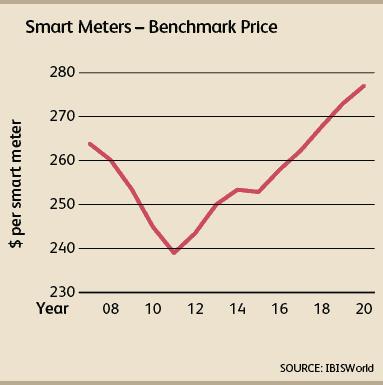Up Your Energy Efficiency And Save Money In The Process
By Anna Son, IBISWorld Procurement Research Analyst
With electricity prices climbing each year and eating up a greater share of companies’ operating expenses, energy efficiency is rightly becoming a top priority for many municipalities and businesses. According to the U.S. EPA, drinking water and wastewater treatment plants account for about 30 to 40 percent of many municipal governments’ total energy consumption. So, by integrating energy-efficient practices into their daily operations, municipalities and utility companies have the potential to save thousands of dollars on energy costs within a few years. While these savings may not happen overnight, investing in renovations and installing energy-efficient equipment pays dividends in the long run — not only for companies, but for the environment as well. Below are just some of the methods that IBISWorld recommends to help municipalities, utility companies, and other businesses in lowering their electricity costs and their ecological footprint.
Smart Meters Equal Smarter Savings
In an effort to slash energy costs, municipalities are increasingly transitioning to more efficient power grid systems that use smart meters. The smart grid system is a new, streamlined energy system that not only improves communication for consumers, but also joins multiple energy resources to generate electricity. Although most smart meters monitor and measure electricity consumption, others can also monitor gas and water flow. IBISWorld estimates that the average price of smart meters ranges between $123 and $532, depending on factors like the meter’s features and material composition. While meters that measure electricity, gas, and water are more expensive to buy, they will allow for more streamlined and specific information regarding a facility’s consumption levels and provide tips on how to make that consumption more efficient. Considering that inefficient water use and leaking pipes can add considerably to total energy costs, smart meters are a helpful tool in detecting leaks and conserving water amid rising water shortages across the country. Smart meters can also help businesses budget for energy consumption by giving users the capacity to change the maximum allowable level of usage and remotely change the meter’s billing plan.

In recent years, the federal government has issued a number of grants to support smart meter development, production, and installation. Despite some opposition to smart meter technology due to privacy and health concerns such as headaches and nausea, cities across the country have been increasingly adopting these new systems to lower their energy costs and reduce their environmental impact.
Untapped Market Opportunities
According to the EPA, drinking water and wastewater treatment plants consume the most energy for many municipal governments, with energy costs accounting for about one-third of these facilities’ total operating costs. Many wastewater treatment plants across the U.S. were built decades ago and have not kept up with advances in technology and equipment. As such, while the wastewater treatment industry is trailing behind other industries in adopting new technology to reduce energy consumption, there is a plethora of opportunities to boost energy efficiency and control hefty energy costs. While overhauling the entire infrastructure would take years to accomplish, municipalities and utilities companies can turn to more immediate solutions such as upgrading their outdated equipment, or investing in energy and utility management solutions.
Pumping uses a great amount of energy to treat and deliver water, so wastewater treatment facilities looking to reduce consumption should consider installing more efficient pumping systems and control valves. Control valves — installed on pipes to shut off, initiate, or throttle flows — play an integral role in water management by regulating the flow of materials from the initial pumps (from underground aquifers, rivers, or from wastewater) through to distribution. When purchasing control valves, buyers should note that those equipped with sensors to monitor flow rate, internal pressure and fluid level are typically more expensive. Product prices also vary based on the type of valve, size, and material, with most valves primarily made from cast iron, steel, or brass. Although valves made from expensive materials such as high-quality steel carry a higher price tag, they are more durable and require less frequent replacements, resulting in additional cost savings in the long run. In addition to upgrading equipment, wastewater treatment facilities should also invest in improving how they monitor energy consumption — with smart meters being one of the most viable options.
Municipalities and other businesses operating outside the energy and utility sectors can use energy and utility consulting services to assess their facilities and determine where energy is being wasted and how to save on costs. According to IBISWorld, consulting rates vary widely from $50 to $400 per hour depending on the experience and reputation of the supplier, the scope of the project, and location of the facilities. In addition to consulting services, municipalities and businesses may consider using energy intelligence software and energy data management services to find more ways to improve their energy efficiency. Fortunately, there are many providers in these markets that can assist in reducing energy usage and costs, so those looking to bring consultants or other services on board will be able to shop around for the best price based on their needs.

Use Your Energy Wisely
Boosting energy efficiency in municipal water or wastewater treatment plants and other facilities needs to be a collaborative effort between local governments and utility companies to ensure that businesses and the environment benefit. While utility companies can invest in upgrading outdated equipment, local governments can support the integration of energy-efficient practices by crafting policies and procedures to reduce energy waste and by incentivizing eco-friendly systems. Overall, the EPA projects that implementing energy efficiency measures can save municipalities and utility companies about 15 to 30 percent, translating into greater cost savings for businesses and consumers and reducing the impact of reckless energy usage on the environment.
